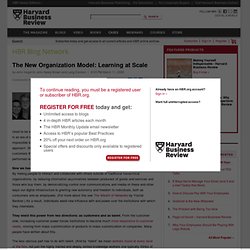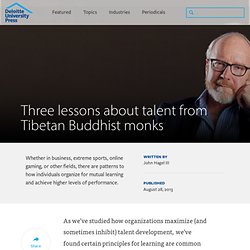

Thrivable » Catalyzing a World that Thrives. The Big Shift: Measuring the forces of deep change, 2009 SHIFT Index - us_tmt_shiftindex_revised_120512.pdf. The New Organization Model: Learning at Scale - John Hagel III, John Seely Brown and Lang Davison - John Hagel III and John Seely Brown. By John Hagel III, John Seely Brown and Lang Davison | 6:03 PM March 11, 2009 In recent posts we’ve described a massive institutional transformation that will occur as part of the big shift: the move from institutions designed for scalable efficiency to institutions designed for scalable learning.

The core questions we all need to address are: who will drive this transformation? Who will be the agents of change? Will it be institutional leaders from above or individuals from below and from the outside of our current institutions? Used to be institutional leaders were the only ones who could change institutions. Now we have a new infrastructure, a digital infrastructure creating near-constant disruption. They wield this power from two directions: as customers and as talent. The less obvious part has to do with talent. That’s because a rapid rate of innovation cannot be programmed from above. How to Bring the Core to the Edge - John Hagel III, John Seely Brown and Lang Davison - John Hagel III and John Seely Brown. By John Hagel III, John Seely Brown and Lang Davison | 6:10 PM February 6, 2009 As the deep forces underlying the big shift accelerate the world around us, many people feel a certain helplessness.

Are markets, industries, and even whole economies descending into chaos? Recent financial market turmoil only heightens the fear. Are sudden and nonlinear shifts outrunning our ability to make sense of a chaotic world? Chaos is always frightening. We believe there is a sense-making pattern that can help us understand how change takes place in the economy. To see what we mean, let’s begin by defining our terms. The “edge” takes many forms. Edges also occur at the firm and individual levels. Why are edges so important? The edges and the core are not independent domains.
However, while the incentives to connect are strong, significant barriers make knowledge flows between the edge and the core problematic. A Solution to School District Budget Cuts - Clayton Christensen and Michael Horn - Clayton Christensen. By Clayton Christensen and Michael Horn | 10:08 AM June 17, 2009 In the May 29, 2009 article, “L.A.

Unified School District cancels bulk of summer school programs,” the Los Angeles Times reported that because of the state’s budget woes, L.A. Unified and other school districts in California were taking an axe to their summer school programs for the majority of students. Although this saves costs in the short run, it creates big problems on a few fronts. First, many students will not receive the access to courses they need for graduation and enrichment. Simple and mindless cuts like this often don’t make sense. Policymakers no doubt will be quick to point to various barriers to doing this–from teacher requirements and student-teacher ratio caps in California to the many agencies that would need to sign off to this and are poised to block it. Scaling Edges - Summary of key design principles.
In 2008, consumer goods giant Procter and Gamble (P&G) wanted to create a specialized dishwashing detergent that would indicate when the right amount of soap had been added to a sink full of dirty dishes.

Researchers and developers within the organization were stumped by the challenge, and unsure of how to proceed, decided to look externally for support. P&G posted the innovation challenge with the help of Innocentive, a small, unknown start-up based in Waltham, MA. Using Innocentive’s network platform, P&G described the problem and offered $30,000 to the individual who could come up with a solution. Soon, thanks to Innocentive’s network of experts, P&G had its answer. Italian chemist Giorgia Sgargetta successfully pioneered a dye which met P&G’s needs in her home laboratory.
Innocentive started in 1998, when Alph Bingham and Aaron Schacht, then scientists at pharmaceutical giant Eli Lilly, were brainstorming how the growth of the Internet would affect business. Return to the framework. Three lessons about talent from Tibetan Buddhist monks. As we’ve studied how organizations maximize (and sometimes inhibit) talent development, we’ve found certain principles for learning are common across disciplines.

Whether in business, extreme sports, online gaming, or other fields, there are patterns to how individuals organize for mutual learning and achieve higher levels of performance. We discovered an unexpected example of these persistent patterns at the antipode of the western business world: the Drepung Monastery regarded as the Highest Seat of Learning among the top monasteries in the Tibetan Buddhist tradition, currently located in South India since being displaced from Lhasa, Tibet. Eric Traub—angel investor, entrepreneur, long-time student of Buddhism, human change and accomplishment—has been living and studying at the monastery for months at a time over three years.
For hundreds of years, this monastery has served as a locus of training for the most advanced and dedicated practitioners. 1.